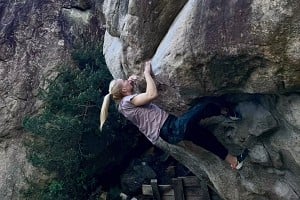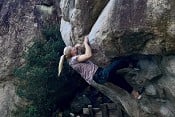In reply to John Workman: The system I used was the locking karabiner method - I tied the skinny rope and the fat rope together in a single overhand loop. I clipped a karabiner in the loop and onto the fat rope. We then abseiled down the fat rope and used the skinny rope to retrieve everything.
I would not trust a sheetbend or the usual overhand knot. Even if there was a good knot to use the skinny rope would go through your abseil device much faster than the fat rope so it would be very difficult to abseil on the two ropes together I think. Mind you, I didn't try it out.
The advantages of the dyneema system are that you have a single rope to use for the climbing which is easier when you are moving together or changing from moving together to pitching regularly. The dyneema weighs very little and is no problem at all to carry.
The disadvantages are many and I chose the system because I thought there was going to be very little abseiling. If I was planning to do lots of abseiling I'd take two half ropes.
As Dave says, the dyneema does not stretch. I clipped the end of the dyneema to my harness so I didn't lose the end and a couple of times I weighted it - there was no stretch at all! The dyneema is very easily tangled, blown away and generally is a bit of a faff.
Clipping a karabiner back into the abseil rope is great but beware of the knot pulling back over the anchor sling making it impossible to retrieve. Having the abseil rope through a maillon is best.
The biggest problem is the greater chance of the ropes getting stuck. The knot is big and bulky, easy to catch on an edge or in a crack. The usual overhand knot used for abseiling on matching topes sits on one side so there is no extra resistance from the knot. In the dyneema system, not only is there a big knot but there is a karabiner being dragged down under the abseil rope, scratching away on the rock the whole way down. It is easily possible for this alone to make too much resistance to pull the ropes. Certainly if there is an edge or corner to go over, it will be very difficult to retrieve the rope.
Of course if the ropes do get stuck you are stuffed - you can't prussick up the dyneema in case it releases and because it is too skinny and you don't have the climbing rope to lead on. You can't lead on the dyneema either because it does not stretch and because it is too skinny to belay.
Lastly, the system takes longer in multi-pitch abseils as you can not thread the next anchor when you are pulling down the ropes.
So, as I say, I'd only choose the system if I was planning few abseils and lots of moving together. I used it to traverse the Rochefort Arete and Grandes Jorasses where there are only three abseils down to the Col des Grandes Jorasses. I practiced the system beforehand as well to get used to it.
Unfortunately, at 5am in the bivi hut on the col, we had a thunder storm which forced us to retreat from the col instead of going over the Jorasses! This involves abseiling a wall that's maybe 400m high! The dyneema system worked perfectly but there were some very tense moments and some very strong tugging on the rope! John (my paying client!) asked me what we would do if the ropes got stuck. I answered "We'd call a helicopter, we'd be stuffed!". Since the ropes did pull every time we both enjoyed the experience but only after we were down.
This year I managed to complete the traverse with John (pictures here -
http://www.flickr.com/photos/abacusmountaineering/sets/72157624471427233/ ) and I chose two half ropes. Ironically we got the ropes stuck on the abseil down to the col! It was also a right faff trying to move together with two half ropes. However, as it is quite a serious place to be, I'm happy with my decision to take two half ropes. After all, it's only a couple of hundred grams of difference.
Hope this helps.
Mike
IFMGA









